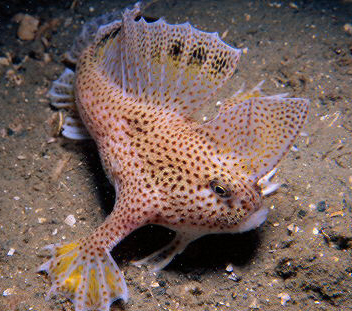
Next week we will explore the diversity of forms in the fish world. The more you study fishes you will see that some fish look so strange to us that it's hard to believe they're real. As you read Chapter 2 on Form and Movement, keep in mind the fundamental premise that all species persist because what they look like and what they do help them to survive, avoid getting eaten before they can attract mates. So what you see when you observe a fish is a unique set of traits that are part of a whole strategy to maximize fitness of individuals in a particular place and time. The photo at the right is a Handfish (Brachionichthys hirsutus).
We study anatomy because it is fundamental to how we classify and name fishes. However, if you remember that form relates to function it will be easier to apply your knowledge of anatomy to new fishes that you encounter. Our current classification system for fishes (from Nelson's Fishes of the World, Fourth Edition 2006) uses many character traits and numerous studies. Louis Agassiz (1807-1873) first classified fishes based on scale type alone: Placodermi had placoid scales, Ganoidei had ganoid scales, Cycloidei had cycloid scales, and Ctenoidei had ctenoid scales. Today we recognize groups of Chondrichthyes (placoid) and Osteichthyes, which contain Chondrostei and Holostei (ganoid scales), and Teleostei (cycloid and ctenoid scales).
Louis Agassiz would evaluate a student's potential for science by placing the student alone in a room with a single fish for a day and periodically pop in to quiz the student about what he had learned. The stories from the paleontologist Nathanael Shaler and Samuel Scudder illustrate this premise that "you can learn a great deal about a fish from its exterior traits."
Read Chapter 2 to learn more. Or if you prefer I will leave you alone in the lab for a week with a single fish. Click on the Comment button below and share with us your thoughts about the unique adaptations of the fish that you would be if you could be a fish. What do the exterior traits of this fish tell you about its habits or habitats?



Have a special scuba diver in your life? Surprise them with one of the Scuba Gear Packages we offer to see their face light up. No matter what the skill level of your significant diver, we have a scuba gear package for them.
ReplyDelete